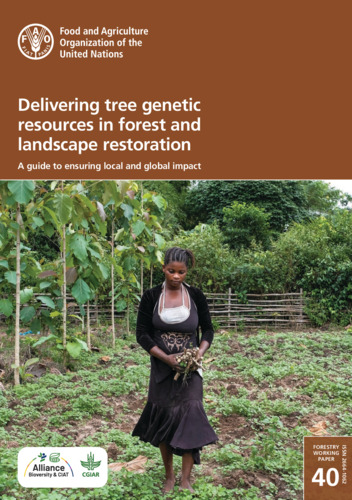Delivering tree genetic resources in forest and landscape restoration. A guide to ensuring local and global impact
In the last 25 years, almost 50 million hectares of primary forest have been lost due to deforestation. Numerous international initiatives such as the Bonn Challenge and the New York Declaration on Forests have set ambitious goals to restore degraded and deforested lands by 2030. Realizing global commitments on forest and landscape restoration (FLR) will require the establishment of billions of trees on millions of hectares of degraded land to address the triple crisis of biodiversity loss, climate change and failing food systems. A significant amount of FLR will require tree planting or increasing tree cover in production landscapes.
The scaled delivery of tree genetic resources (TGR), in other words, the diversity of species and genotypes from seeds and other forest reproductive material, will be critical to achieving impact. Lack of available forest reproductive material undermines the scaling of FLR and its potential to deliver expected benefits. Achieving impact from FLR requires an abundance of seeds and seedlings from many species and sources of genetic diversity within species.
The aim of this working paper is to highlight key challenges and opportunities for the integration of TGR – from genes and species to landscapes – in current FLR projects.
We first explore why TGR are so important and identify the key role that they play in supporting biodiversity, mitigating and adapting to climate change, and enhancing resilient livelihoods. Second, we evaluate the challenges and barriers to scaling the use of TGR in restoration, and how these undermine the potential of FLR to deliver expected benefits. Third, we review recent opportunities and innovations in the latest literature for mainstreaming TGR in FLR and present 13 case studies from around the world, representing state-of-the-art and best practices for TGR conservation and use. We then summarize the findings from these case studies, covering a range of topics from improved in situ and ex situ conservation of TGR, strategies for ensuring high-quality, diverse planting material, and evidence to show how increasing the use of TGR in FLR can increase benefits, locally and globally.
We provide practical guidelines for improving integration of TGR in FLR, for consideration by a wide range of stakeholders, in particular: (1) countries and national policymakers; (2) donors and funding bodies; (3) international organizations and regional networks; and (4) restoration practitioners. Finally, we present a list of eight key recommendations to support the delivery of TGR for maximizing restoration outcomes towards
reversing biodiversity loss, mitigating and adapting to climate change, and supporting sustainable food systems and improved livelihoods. We hope that this paper will contribute to achieving the United Nations Sustainable Development Goals (SDGs), specifically SDGs 1 (No Poverty), 2 (Zero Hunger), 13 (Climate Action) and 15 (Life on Land) through greater and more effective use of TGR in FLR implementation.

